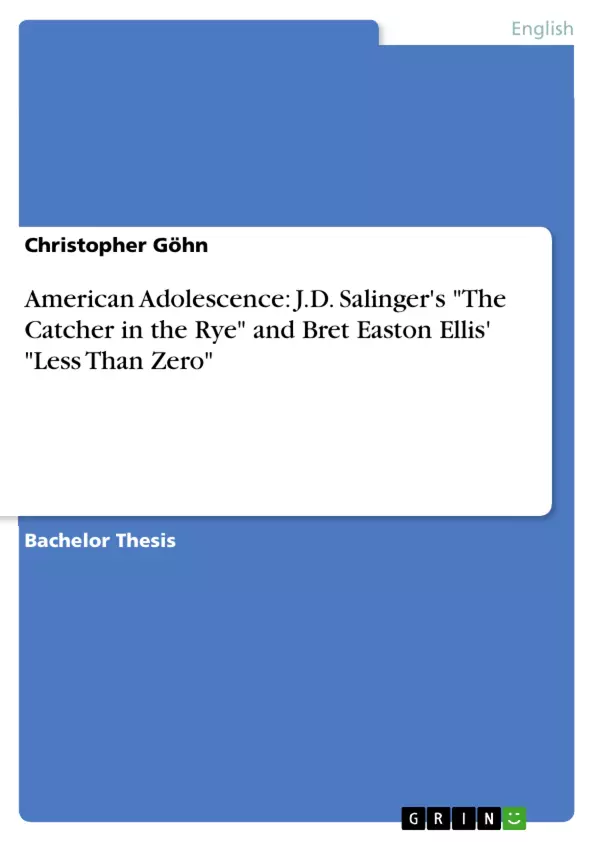American Literature thematizing youth, adolescence and initiation draws on a long tradition reaching back to the 18th century, including writers like Herman Melville, Mark Twain, Henry James and William Faulkner. After the Second World War, the American novel of adolescence flourished again in a period that also gave birth to the genre's arguably most prominent representative:
When J.D. Salinger's novel The Catcher in the Rye first entered the American book market in 1951, its critical reception could not have diverged more. Salinger's first novel, after publishing a number of short stories in the New Yorker, was mostly attacked for its extensive use of colloquial language. Initial reviews ranged from “an unusual brilliant first novel” to “wholly repellent in its mingled vulgarity [...] and sly perversion”.
In 1985, thirty-four years later, Less Than Zero, the first novel of Bennington College student Bret Easton Ellis, was published and also received widely mixed criticism. While Interview Magazine called his debut “startling and hypnotic”, Paul Gray wrote in an article for Time Magazine that the novel “offers little more than its title promises”, referring to its lack of depth and fully developed characters.
The first part of this work will lay the theoretical foundations and discuss the genre of the novel of adolescence in respect to the two novels under investigation.
After covering the theoretical basics, the second part of this paper intends to concentrate on detecting parallels in the themes and presentations of adolescence and initiation in both works. Since social criticism is always a central genre-specific characteristic of the novel of adolescence, the next part will briefly discuss this issue in respect to The Catcher in the Rye as well as Less Than Zero and point to a possible interpretation of a diachronic development of American society that the two novels delineate. Subsequently, the focus will be shifted to the final chapters of both novels and center upon questions concerning epiphanies, progress and outlook for the respective protagonist.
Eventually, this paper intends to give a far reaching picture of the presentation of adolescence in two novels from very different backgrounds, that, in all their diversity, are so astoundingly similar.
Table of Contents
- Introduction
- The Catcher in the Rye and Less Than Zero as Novels of Adolescence
- The Novel of Adolescence
- The Catcher in the Rye and the Novel of Adolescence
- Less Than Zero and the Novel of Adolescence
- Initiation in Salinger and Ellis
- The Catcher in the Rye: An “Initiationsreiseroman”
- Less Than Zero: A Deconstruction of the “Initiationsreiseroman”?
- Symbols, Motifs and Themes of Adolescence
- Symbols and Verbal Iterations
- Family, Friends and Tutors
- Childhood, Innocence and Change
- Communication and Isolation
- The Media and Consumerism
- The Dimension of Social Criticism
- The Protagonists: Epiphanies, Progress and Outlook
Objectives and Key Themes
This paper aims to analyze the presentation of adolescence in J.D. Salinger's The Catcher in the Rye and Bret Easton Ellis' Less Than Zero, exploring their similarities and differences as novels of adolescence. The paper will investigate the genre of the novel of adolescence, examining its key characteristics and how these are embodied in both texts.- The genre of the novel of adolescence and its defining features
- The portrayal of initiation and psychological development in both novels
- Themes of innocence, isolation, and social criticism in the context of adolescent experience
- The impact of societal influences on adolescent identity and worldview
- The protagonists' journeys toward self-discovery and their outlook on the future
Chapter Summaries
- The introduction sets the stage for the analysis by outlining the historical context of American literature focusing on youth and adolescence, introducing the two novels under study, and establishing the overarching objective of the paper.
- The second chapter defines the genre of the novel of adolescence by examining its key themes, structures, and characteristics, applying these concepts to both The Catcher in the Rye and Less Than Zero to assess their relevance to the genre.
- The third chapter delves into the concept of initiation and the “Initiationsreiseroman” as a specific subgenre, exploring how Salinger’s The Catcher in the Rye exemplifies this narrative structure and how Ellis's Less Than Zero potentially deconstructs or redefines it.
- The fourth chapter focuses on recurring symbols, motifs, and themes that highlight the adolescent experience in both novels, including themes such as family, friends, innocence, communication, isolation, and consumerism.
- The fifth chapter examines the social criticism embedded in both novels, exploring how they comment on the societal pressures and expectations faced by adolescents and their impact on individual development.
Keywords
This paper delves into the world of adolescent experiences through a comparative analysis of two iconic American novels, The Catcher in the Rye and Less Than Zero. The key focus is on the portrayal of adolescence in the context of the novel of adolescence genre, examining the themes of initiation, identity formation, social criticism, and the protagonists' journeys toward self-discovery.- Quote paper
- Christopher Göhn (Author), 2008, American Adolescence: J.D. Salinger's "The Catcher in the Rye" and Bret Easton Ellis' "Less Than Zero", Munich, GRIN Verlag, https://www.grin.com/document/137276



